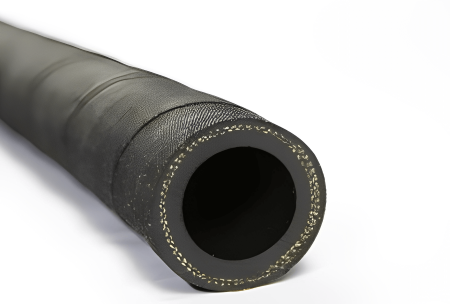Hydraulic systems form the backbone of industries ranging from construction to manufacturing, powering machinery that accomplishes heavy lifting, precise movement, and more. Central to these systems are hydraulic hose parts – the unsung heroes that ensure the smooth flow of hydraulic fluids.
In this article, we’ll take a detailed journey into the world of hydraulic hose parts, unraveling their intricate design, roles, and importance in powering modern industries.
Anatomy of a Hydraulic Hose
Imagine a hydraulic hose as a complex network of components working harmoniously to transmit fluid power. Each of these components plays a distinct role in maintaining the integrity and efficiency of the hydraulic system.
Inner Tube: The Conduit of Fluid Power
At the core of a hydraulic hose lies the inner tube, an often-underestimated component responsible for guiding hydraulic fluids. Crafted from materials like synthetic rubber or thermoplastics, the inner tube acts as a conduit through which hydraulic fluids flow under immense pressure. This inner tube must be chosen with precision, as different materials interact uniquely with various hydraulic fluids, ensuring the fluid’s compatibility and preventing leaks that could compromise system performance.
Reinforcement Layers: Strength Under Pressure
Surrounding the inner tube are reinforcement layers, designed to withstand the tremendous pressure that hydraulic systems endure. These layers, composed of materials like steel, textile fibers, or wire, provide structural integrity and resilience to the hose. Whether it’s the high-tensile steel braids of heavy-duty applications or the textile layers for lighter tasks, the reinforcement determines the hose’s working pressure limits and overall durability.
Outer Cover: Protection and Durability
The outer cover serves as the final line of defense for hydraulic hoses. Crafted from materials like synthetic rubber or thermoplastics, the outer cover shields the hose from abrasion, extreme temperatures, and the harsh effects of the environment. This protective layer ensures the longevity of the hydraulic hose, safeguarding its inner components from wear and tear caused by external factors.
Understanding Fittings and Connectors
Hydraulic hose parts wouldn’t fulfill their potential without hydraulic fittings – the essential connectors that join hoses to other components. These fittings enable the seamless transmission of fluid power, making the entire hydraulic system a cohesive unit.
Types of Hydraulic Fittings
In the realm of hydraulic fittings, there exist several types that cater to different needs and scenarios. Understanding these fittings is crucial for creating efficient and reliable hydraulic connections.
Crimped Fittings: Permanent Connections
Crimped fittings, also known as permanent fittings, are a staple in hydraulic connections. By crimping the fitting onto the line using specialist equipment, these fittings provide a safe and leak-free connection. The crimping process creates a tight and reliable seal that withstands the rigors of hydraulic systems. Industries rely on crimped fittings for their durability and ability to maintain consistent pressure and fluid transmission.
Reusable Fittings: Flexibility and Convenience
In scenarios where flexibility is paramount, reusable fittings take the stage. As the name implies, these fittings can be disassembled and reassembled multiple times without compromising performance. This reusability factor is particularly advantageous for applications that require frequent hose changes or adjustments. By utilizing clamps, ferrules, or other mechanical means, reusable fittings provide a convenient solution while maintaining secure connections.
Quick-Disconnect Fittings: Swift and Efficient
For applications that demand swift connections and disconnections, quick-disconnect fittings come to the rescue. These fittings are designed to expedite the process of connecting and disconnecting hoses, saving valuable time in industries where efficiency is paramount. Their simple yet effective design allows operators to swiftly swap out hoses without the need for elaborate tools or excessive downtime.
Common Issues and Maintenance
Despite their robust design, hydraulic hose parts are subject to wear and tear over time. Common issues such as leaks, abrasion, and wear can compromise the integrity of hydraulic systems. Regular maintenance practices such as inspecting hoses for signs of damage, replacing worn-out parts, and ensuring proper installation play a pivotal role in preventing potential problems and extending the lifespan of hydraulic hoses.
Selecting the Right Hose Parts
Choosing the appropriate hydraulic hose parts is a critical decision that directly impacts the efficiency and safety of the hydraulic system. The right combination of inner tube material, reinforcement layers, and outer cover material ensures compatibility with specific applications and hydraulic fluids. It’s essential to consider factors like temperature, pressure, and fluid type to make an informed choice that guarantees optimal performance.
Importance of Proper Installation
The journey of a hydraulic hose doesn’t end with the selection of the right parts. Proper installation is equally crucial for ensuring the reliability and longevity of the hydraulic system. Incorrect installation practices can lead to leaks, pressure loss, and even catastrophic hose failure. Employing proper techniques, utilizing appropriate tools, and following manufacturer guidelines are imperative for establishing secure connections and preventing potential hazards.
Conclusion
In the grand tapestry of hydraulic systems, hydraulic hose parts play an indispensable role. The intricate components of the inner tube, reinforcement layers, and outer cover collaborate to create a robust conduit for fluid power. The array of hydraulic fittings enhances this system by providing secure and efficient connections, enabling machinery to operate seamlessly.
Understanding the anatomy of hydraulic hose parts, selecting the right components, and ensuring proper installation collectively contribute to reliable, efficient, and safe hydraulic systems across a wide range of industries.
Post time: Aug-24-2023


